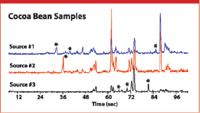Volatile and Semivolatile Compound Screening of Cocoa Raw Materials and Finished Chocolate Products Using Headspace SPME-GC-TMS
Solid phase microextraction (SPME) was used to generate volatile and semivolatile compound profiles of raw materials used in the production of chocolate products.
Solid phase microextraction (SPME) was used to generate volatile and semivolatile compound profiles of raw materials used in the production of chocolate products. The headspace of cocoa beans, cocoa butter, and finished chocolate were sampled using SPME and analyzed using a portable gas chromatograph-toroidal ion trap mass spectrometer (GC-TMS).
The quality of raw materials used for the production of chocolate greatly impacts finished product quality. Volatile and semivolatile organic compounds (VOCs, SVOCs) found in products from cocoa beans indicative of quality can be identified. Analysis of raw materials prior to use can be advantageous since chemical defects such as subtle molding or elevated free fatty acid content resulting from improper storage can impact taste and odor characteristics. By detecting off-flavor compounds early in the manufacturing process, raw materials can be eliminated thus decreasing rejection rates of finished products not meeting quality standards. Headspace SPME combined with portable GC-TMS is an effective tool for the on-site analysis of VOCs and SVOCs at the point of origin or upon receipt. In addition to cocoa beans, pre-screening of finished products can be broadly applied to numerous foodstuffs as a measure of food quality and safety.
Experimental Conditions
Cocoa beans, cocoa butter, and finished chocolate product were provided by Theo Chocolate (Seattle, Washington). A CUSTODION®-12 SPME syringe (Torion Technologies Inc., American Fork, Utah) with a 65 μm polydimethylsiloxane/divinylbenzene (PDMS/DVB) fiber was used for extraction by exposing the fiber directly into the headspace above each sample for 20 s to 20 min at elevated temperatures (45–65 °C) to improve sample off-gassing of VOCs and SVOCs. The SPME syringe was inserted into the GUARDION®-7 GC-TMS (Torion Technologies Inc., American Fork, Utah) injection port where the target analytes were desorbed into a low thermal mass injector (270 °C) coupled with a capillary GC column (MXT-5, 5 m × 0.1 mm, 0.4 μm df [Restek, Bellefonte, Pennsylvania]). After an initial 10 s hold at 50 °C, the GC temperature was increased at 2 °C/s to 280 °C. The capillary GC is coupled to a TMS detector having a mass range of 50–500 m/z.
Results
Figure 1 shows the GC-TMS chromatograms for three organically cultivated, fermented, dried cocoa beans from different sources. Key components in the headspace eluted in less than 90 s under the GC-TMS conditions listed above. Peaks marked with an (*) represent candidate VOC and SVOC markers which potentially can be used to evaluate the acceptability of a raw material shipment.

Figure 1: Chromatogram of cocoa bean headspace from three sources (PDMS/DVB SPME fiber, 20 min exposure, 65 °C).
Conclusions
VOCs and SVOCs from foods and commodities can be quickly analyzed at the source using headspace SPME-GC-TMS. Using the CUSTODION-12 SPME syringe and GUARDION-7 GC-TMS, screening of marker compounds can support rapid decision making for purchases of raw materials, providing critical information at the commodity source. The short GC-TMS analysis time allows the user to quickly analyze multiple samples on-site.
Acknowledgements
CUSTODION® and GUARDION® are registered trademarks of Torion Technologies Inc. The CUSTODION SPME syringe and GUARDION-7 GC-TMS are manufactured and sold under license from (1) Brigham Young University under US Patent Application 11/379,716 and (2) the SPME fibers are sold under license from SUPELCO under US Patent 5,691,206, and/or any divisions, continuations, or revisions thereof.

Torion Technologies Inc.
796 East Utah Valley Drive, Suite 200, American Fork, UT 84003
tel. (801)705-6600
Email: information@torion.com
Website: www.torion.com
















